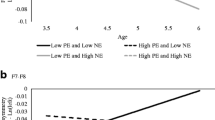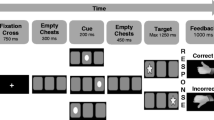Abstract
An atypical EEG pattern of frontal brain activation, which has been found in children and adults with emotional disorders, also is hypothesized to be present in disruptive behavior disorders. One hundred nineteen children (4\(\frac{1}{2}\) and 8 years of age) were examined with regard to the following questions: (1) Do children who are diagnosed with oppositional defiant disorder (ODD) exhibit an atypical pattern of frontal brain activation? (2) Can this pattern be demonstrated in preschool children (4\(\frac{1}{2}\) years of age) as well as in school children (8 years)? (3) Are there gender differences in these patterns similar to those that have been demonstrated in adults? Spontaneous EEG activity was subjected to power spectral analysis. In oppositional preschool and elementary school girls, the well-known pattern of lower left frontal than right frontal activation emerged that has been found previously in emotionally disordered children. Healthy girls showed no frontal brain asymmetry at 4\(\frac{1}{2}\) years of age, and left frontal activation at 8 years. In contrast, healthy boys demonstrated a greater right than left frontal activation, whereas ODD boys did not display any frontal brain asymmetry. Thus, the pattern of frontal brain activation seems to be gender-specific. The atypical activation pattern in oppositional children is hypothesized to be a biological substrate of negative affective style.
Similar content being viewed by others
REFERENCES
Allen, J. J., Iacono, W. G., Depue, R. A., & Arbisi, P. (1993). Regional electroencephalographic asymmetries in bipolar seasonal affective disorder before and after exposure to bright light. Biological Psychiatry, 33, 642–646.
Anderson, R. H., Fleming, D. E., Rhees, R. W., & Kinghorn, E. (1986). Relationships between sexual activity, plasma testosterone and the volume of the sexually dimorphic nucleus of the preoptic area in prenatally stressed and non-stressed rats. Brain Research, 370, 1–10.
Barkley, R. A. (1997). Behavioral inhibition, sustained attention, and executive functions: Constructing a unifying theory of ADHD. Psychological Bulletin, 121, 65–94.
Baving, L., Laucht, M., & Schmidt, M. H. (1999). Atypical frontal brain activation in ADHD: Preschool and elementary school boys and girls. Journal of the American Academy of Child and Adolescence Psychiatry, 38, 1363–1371.
Birbaumer, N., & Töpfner, S. (1998). Hirnhemisphären und Verhalten. Deutsches Ärzteblatt, 95, 2844–2848.
Burgemeister, B., Blum, L., & Lorge, J. (1972). Columbia Mental Maturity Scale. New York: Harcourt Brace Jovanovich.
Campbell, S. B. (1995). Behavior problems in preschool children: A review of recent research. Journal of Child Psychology and Psychiatry, 36, 113–149.
Campbell, S. B., Pierce, E. W., March, C. L., Ewing, L. J., & Szumowski, E. K. (1994). Hard-to-manage preschool boys: Symptomatic behavior across contexts and time. Child Development, 65, 836–851.
Cantwell, D. P., & Baker, L. (1989). Stability and natural history of DSM-III childhood diagnoses. Journal of the American Academy of Child and Adolescence Psychiatry, 28, 691–700.
Davidson, R. J. (1995). Cerebral asymmetry, emotion, and affective style. In R. J. Davidson & K. Hugdahl (Eds.), Brain Asymmetry (pp. 361–387). Cambridge: MIT Press.
Davidson, R. J. (1998a). Affective style and affective disorders: Perspectives from affective neuroscience. Cognition and Emotion, 12, 307–330.
Davidson, R. J. (1998b). Anterior electrophysiological asymmetries, emotion, and depression: Conceptual and methodological conundrums. Psychophysiology, 35, 607–614.
Davidson, R. J., & Fox, N. A. (1989). Frontal brain asymmetry predicts infants' response to maternal separation. Journal of Abnormal Psychology, 98, 127–131.
Davidson, R. J., Schaffer, C. E., & Saron, C. (1985). Effects of lateralized presentations of faces on self-reports of emotion and EEG asymmetry in depressed and non-depressed subjects. Psychophysiology, 22, 353–364.
Dawson, G., Frey, K., Panagiotides, H., Osterling, J., & Hessl, D. (1997). Infants of depressed mothers exhibit atypical frontal brain activity: A replication and extension of previous findings. Journal of Child Psychology and Psychiatry, 38, 179–186.
Dawson, G., Frey, K., Panagiotides, H., Yamada, E., Hessl, D., & Osterling, J. (1999). Infants of depressed mothers exhibit atypical frontal electrical brain activity during interactions with mother and with a familiar, nondepressed adult. Child Development, 70, 1058–1066.
Dawson, G., Grofer Klinger, L., Panagiotides, H., Hill, D., & Spieker, S. (1992c). Frontal lobe activity and affective behaviour of infants of mothers with depressive symptoms. Child Development, 63, 725–737.
Dawson, G., Grofer Klinger, L., Panagiotides, H., Spieker, S., & Frey, K. (1992b). Infants of mothers with depressive symptoms: Electrophysiological and behavioral findings related to attachment status. Developmental Psychopathology, 4, 67–80.
Dawson, G., Panagiotides, H., Grofer Klinger, L., & Hill, D. (1992a). The role of frontal lobe functioning in the development of infant self-regulatory behavior. Brain and Cognition, 20, 152–175.
De Lacoste, M. C., Horvath, D. S., & Woodward, D. J. (1991). Possible sex differences in the developing human fetal brain. Journal of Clinical and Experimental Neuropsychology, 13, 831–846.
Ernst, M., Cohen, R. M., Liebenauer, L. L., Jons, P. H., & Zametkin, A. J. (1997). Cerebral glucose metabolism in adolescent girls with attention-deficit/hyperactivity disorder. Journal of the American Academy of Child and Adolescence Psychiatry, 36, 1399–1406.
Ernst, M., Liebenauer, L. L., King, C., Fitzgerald, G. A., Cohen, R. M., & Zametkin, A. J. (1994). Reduced brain metabolism in hyperactive girls. Journal of the American Academy of Child and Adolescence Psychiatry, 33, 858–868.
Esser, G., Blanz, B., Geisel, B., & Laucht, M. (1989). Mannheimer Elterninterview. Weinheim: Beltz.
Esser, G., Schmidt, M. H., & Woerner, W. (1990). Epidemiology and course of psychiatric disorders in school-age children-results of a longitudinal study. Journal of Child Psychology and Psychiatry, 31, 243–263.
Fox, N. A., & Davidson, R. J. (1988). Patterns of brain electrical activity during facial signs of emotion in 10-month-old infants. Developmental Psychology, 24, 230–236.
Fox, N. A., Rubin, K. H., Calkins, S. D., Marshall, T. R., Coplan, R. J., Porges, S. W., Long, J., & Stewart, S. (1995). Frontal activation asymmetry and social competence at four years of age. Child Development, 66, 1770–1784.
Fox, N. A., Schmidt, L. A., Calkins, S. D., Rubin, K. H., & Coplan, R. J. (1996). The role of frontal activation in the regulation and dysregulation of social behavior during the preschool years. Developmental Psychopathology, 8, 89–102.
Harmon-Jones, E., & Allen, J. J. B. (1997). Behavioral activation sensitivity and resting frontal EEG asymmetry: Covariation of putative indicators related to risk for mood disorders. Journal of Abnormal Psychology, 106, 159–163.
Henriques, J. B., & Davidson, R. J. (1990). Regional brain electrical asymmetries discriminate between previously depressed subjects and healthy controls. Journal of Abnormal Psychology, 99, 22–31.
Henriques, J. B., & Davidson, R. J. (1991). Left frontal hypoactivation in depression. Journal of Abnormal Psychology, 100, 535–545.
Jensen, P. S., Martin, D., & Cantwell, D. P. (1997). Comorbidity in ADHD: Implications to research, practice, and DSM-V. Journal of the American Academy of Child and Adolescent Psychiatry, 36, 1065–1079.
Jones, N. A., Field, T., Fox, N. A., Lundy, B., & Davalos, M. (1997). EEG activation in 1-month-old infants of depressed mothers. Developmental Psychopathology, 9, 491–505.
Keenan, K., & Shaw, D. (1997). Developmental and social influences on young girls' early problem behavior. Psychological Bulletin, 121, 95–113.
Kline, J. P., Allen, J. J. B., & Schwartz, G. E. (1998). Is left frontal brain activation in defensiveness gender specific? Journal of Abnormal Psychology, 107, 149–153.
Lahey, B. B., Applegate, B., Barkley, R. A., Garfinkel, B., McBurnett, K., Kerdyk, L., Greenhill, L., Hynd, G.W., Frick, P. J., Newcorn, J., Biederman, J., Ollendick, T., Hart, E. L., Perez, D., Waldman, I., & Shaffer, D. (1994). DSM-IV field trials for oppositional defiant disorder and conduct disorder in children and adolescents. American Journal of Psychiatry, 151, 1163–1171.
Larson, C. L., Davidson, R. J., Abercrombie, H. C., Ward, R. T., Schaefer, S. M., Jackson, D. C., Holden, J. E., & Perlman, S. B. (1998). Relations between PET-derived measures of thalamic glucose metabolism and EEG alpha power. Psychophysiology, 35, 162–169.
Laucht, M., Esser, G., & Schmidt, M. H. (1997). Developmental outcome of infants born with biological and psychosocial risks. Journal of Child Psychology and Psychiatry, 38, 843–853.
Lewis, D. W., & Diamond, M. C. (1995). The influence of gonadal steroids on the asymmetry of the cerebral cortex. In R. J. Davidson & K. Hugdahl (Eds.), Brain Asymmetry (pp. 31–50). Cambridge: MIT Press.
Loeber, R., Lahey, B. B., & Thomas, C. (1991). Diagnostic conundrum of oppositional defiant disorder and conduct disorder. Journal of Abnormal Psychology, 100, 379–390.
Murray, L., & Cooper, P. J. (1997). Postpartum depression and child development. Psychological Medicine, 27, 253–260.
Osaka, M., & Osaka, N. (1980). Human intelligence and power spectral analysis of visual evoked potentials. Perceptual and Motor Skills, 50, 192–194.
Rey, J. M. (1993). Oppositional defiant disorder. American Journal of Psychiatry, 150, 1769–1778.
Schmidt, L. A., & Fox, N. A. (1994). Patterns of cortical electrophysiology and autonomic activity in adults' shyness and sociability. Biological Psychology, 43, 183–198.
Steriade, M. (1981). EEG desynchronization is associated with cellular events that are prerequisites for active behavioral states. Commentary on “Reticulo-cortical activity and behavior. A critique of the arousal theory and a new synthesis” by C. H. Vanderwolf & T. E. Robinson. Behavioral and Brain Sciences, 4, 489–492.
Tomarken, A. J., & Davidson, R. J. (1994). Frontal brain activation in repressors and nonrepressors. Journal of Abnormal Psychology, 103, 339–349.
Tomarken, A. J., Davidson, R. J., & Henriques, J. B. (1990). Frontal brain asymmetry predicts affective responses to films. Journal of Personality and Social Psychology, 59, 791–801.
Ward, I. L, & Weisz, J. (1980). Maternal stress alters plasma testosterone in fetal males. Science, 207, 328–329.
Weiss, R., & Osterland, J. (1979). Grundintelligenztest Skala 1 (3rd edition). Braunschweig: Westermann.
Wheeler, R. E., Davidson, R. J., & Tomarken, A. J. (1993). Frontal brain asymmetry and emotional reactivity: A biological substrate of affective style. Psychophysiology, 30, 82–89.
Wiedemann, G., Pauli, P., Dengler, W., Lutzenberger, W., Birbaumer, N., & Buchkremer, G. (1999). Frontal brain asymmetry as a biological substrate of emotions in patients with panic disorder. Archives of General Psychiatry, 56, 78–84.
Author information
Authors and Affiliations
Rights and permissions
About this article
Cite this article
Baving, L., Laucht, M. & Schmidt, M.H. Oppositional Children Differ from Healthy Children in Frontal Brain Activation. J Abnorm Child Psychol 28, 267–275 (2000). https://doi.org/10.1023/A:1005196320909
Issue Date:
DOI: https://doi.org/10.1023/A:1005196320909




